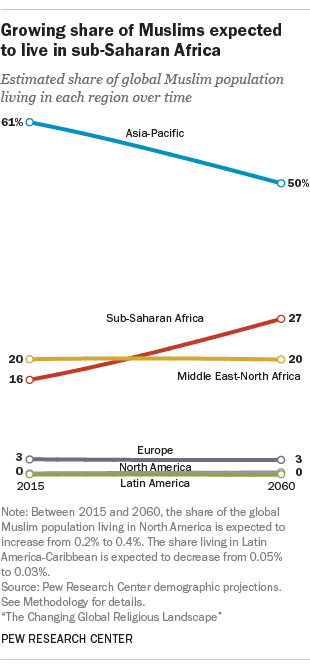 If demography is destiny, then Christianity’s future lies in Africa. By 2060, a plurality of Christians – more than four-in-ten – will call sub-Saharan Africa home, up from 26% in 2015, according to a new analysis of demographic data by Pew Research Center. At the same time, the share of Christians living in many other regions – notably Europe – is projected to decline.
If demography is destiny, then Christianity’s future lies in Africa. By 2060, a plurality of Christians – more than four-in-ten – will call sub-Saharan Africa home, up from 26% in 2015, according to a new analysis of demographic data by Pew Research Center. At the same time, the share of Christians living in many other regions – notably Europe – is projected to decline.
This shift in the regional concentration of the global Christian population is being driven by a combination of demographic factors, including fertility, age and migration, as well as religious switching into and out of Christianity. In sub-Saharan Africa, Christians, on average, are relatively young and have more children than their coreligionists elsewhere, contributing to the projected rapid population growth in the decades ahead.
By contrast, European Christians are much older and have fewer children. In addition, large numbers of Europeans who were born Christian are leaving the faith to join the ranks of the religiously unaffiliated. As a result, the share of all Christians living in Europe is expected to decline from nearly a quarter in 2015 to just 14% by 2060. Religious switching out of Christianity also is projected to drive down the share of the global Christian population in North America (12% in 2015 to 9% in 2060).
 Sub-Saharan Africa also is home to a growing share of the world’s Muslims. Between 2015 and 2060, the share of all Muslims living in the region is projected to increase from 16% to 27%. Although the majority of Muslims will continue to live in the Asia-Pacific region (50% of the global Muslim population in 2060), sub-Saharan Africa will surpass the Middle East-North Africa as the region with the second-largest Muslim population in the next 20 years.
Sub-Saharan Africa also is home to a growing share of the world’s Muslims. Between 2015 and 2060, the share of all Muslims living in the region is projected to increase from 16% to 27%. Although the majority of Muslims will continue to live in the Asia-Pacific region (50% of the global Muslim population in 2060), sub-Saharan Africa will surpass the Middle East-North Africa as the region with the second-largest Muslim population in the next 20 years.
As with Christianity, Muslim growth in sub-Saharan Africa primarily is driven by high fertility and the relatively young age profile of the population in the region. Religious switching is expected to play a minor role in future Muslim population trends around the world. In fact, in many Muslim-majority countries in the Middle East and North Africa, apostasy laws remain on the books, helping to make changes in religious identity rare.
Other religious group will also, to some degree, experience population shifts.
Currently, around three-in-four people who identify with no religion, including atheists and agnostics, live in Asia and the Pacific. But that share is expected to decline to 66% by 2060 due to low fertility and an aging population. At the same time, a growing share of the unaffiliated will live outside of the Asia-Pacific region, particularly in Europe and North America where religious switching from Christianity is fueling rapid growth. By 2060, 9% of the world’s unaffiliated population is projected to live in the United States alone.
The vast majority of Hindus and Buddhists (99% and 98%, respectively) will continue to live in the Asia-Pacific region in the next several decades. Most practitioners of folk religions, too, will remain in Asia and the Pacific (79% in 2060), although a growing share are expected to live sub-Saharan Africa as well (7% in 2015 vs. 16% in 2060).
Roughly equal shares of the world’s Jews lived in Israel (42%) and the United States in 2015 (40%). But by 2060, over half of all Jews (53%) will live in Israel while a smaller share – 32% – will be in the U.S. The shift will be driven, in part, by high fertility of Orthodox Jews, who make up a larger share of all Jews in Israel than in the U.S.


